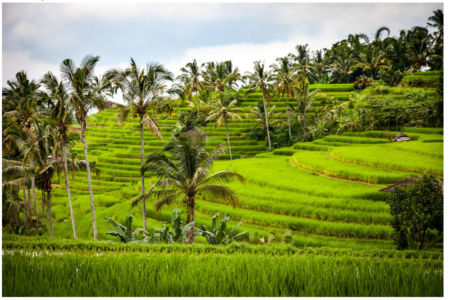by Sandee LaMotte
Updated May 15, 2025

Some Asian families are aware of the presence of heavy metals in rice, but not the dangers posed by arsenic, said Gloria Tan, executive director of Gum Moon’s women’s residence at the Asian Women’s Resource Center in San Francisco. Gum Moon, which stands for “golden door,” has been providing services to Asian women since 1868 and was a partner in the new report.
*heavy metals: 중금속
*executive director: (기업체의) 전무 이사, 상무 이사
*Resource Center: 지원센터
“Knowing that there are dangers of arsenic might make families reconsider their rice choice,” Tan said in an email. “I think some families may be receptive to the idea of switching to a less contaminated grain.”
*receptive: 수용적인, 선뜻 받아들이는 (=responsive)
*the idea of switching to a less contaminated grain: 덜 오염된 곡식으로 바꾸려는 생각
The new report analyzed the total heavy metal content in 145 samples of rice varieties grown in India, Italy, Thailand and the United States that were purchased by shoppers in the US.
*in 145 samples of rice varieties: 쌀 품종 145개의 샘플 속에 든
“The researchers used a certified, accredited lab to measure arsenic and other heavy metals in rice samples, confirming that this is an issue with real-world implications,” said Tasha Stoiber, a senior scientist at the Environmental Working Group, via email. EWG is a consumer organization that monitors exposure to heavy metals, plastics, and other dangerous chemicals. Stoiber was not involved in the new research.
*a certified, accredited lab: 공인된 실험실
*an issue with real-world implications: 현실에 존재하는 영향력을 가진 문제
*implications: 결과, 영향
*a consumer organization that monitors exposure to heavy metals, plastics, and other dangerous chemicals: 중금속, 플라스틱, 그리고 다른 유해 화학물질에 대한 노출을 감시하는 소비자 단체
The independent lab also tested another 66 samples of nine ancient grains: amaranth, barley, buckwheat, bulgur, couscous, farro, millet, quinoa, and spelt (wheat).
*nine ancient grains: amaranth, barley, buckwheat, bulgur, couscous, farro, millet, quinoa, and spelt: 9가지 고대 곡식: 아마란스, 보리, 메밀, 벌거(밀을 반쯤 삶아서 말렸다가 빻은 것), 쿠스쿠스(으깬 밀), 통보리, 수수, 퀴노아(남미에서 식용이나 술 제조용으로 기르는 작물), 독일 소맥(=German wheat=spelt wheat)
Results showed rice purchased by shoppers contained 28 times more arsenic than the alternative grains. The group of alternative grains, however, contained 1.5 times more cadmium than rice. Still, overall levels of heavy metals were three times lower in the nine grains compared with the levels found in the purchased rice.
*shopper: 쇼핑객
*alternative grains: 대안 곡류, 대체 곡류
*The group of alternative grains, however, contained 1.5 times more cadmium than rice: 그러나, 대안 곡류 집단은 쌀보다 카드뮴을 1.5배 더 많이 내포하고 있었습니다.
Like arsenic, cadmium easily crosses the placental barrier to the fetus, potentially causing neurodevelopmental harm. Cadmium is also a known carcinogen and has been connected to harm to the kidneys, bones, stomach, lungs, and more.
*cadmium easily crosses the placental barrier to the fetus: 카드뮴은 쉽게 태반장벽을 뚫고 태아에게 도달합니다.
*potentially causing neurodevelopmental harm: 잠재적으로 신경발달 장애를 일으키며
*a known carcinogen: 알려진 발암물질
*connected to harm to the kidneys, bones, stomach, lungs, and more: 신장, 뼈, 위장, 허파 등을 손상시키는 것과 연관된
“Most research has focused solely on arsenic, but that leaves out an important part of the rice safety story,” Houlihan said. “By including cadmium in our analysis, we’re able to give a more complete picture of how different rice types compare in terms of overall toxic metal exposure.”
*leave out: 빼다, 생략하다
*in terms of ~: ~면에서
*in terms of overall toxic metal exposure: 종합적인 독성 금속에 대한 노출 측면에서
<Translation>
샌프란시스코에 있는, 아시아 여성 자원 센터(Asian Women’s Resource Center) 산하 Gum Moon 여성 거주지의 글로리아 탄(Gloria Tan) 전무 이사는, 일부 아시아 가정은 쌀에 중금속이 포함되어 있다는 사실을 알고 있지만, 비소의 위험성에 대해서는 잘 모른다고 말했습니다.
1868년부터 아시아 여성들을 위해 서비스를 제공해온 Gum Moon(금문이라는 뜻)은, 이번 새로운 보고서의 파트너로 참여했습니다.
"비소의 위험성을 알게 되면, 가족들이 쌀 선택을 다시 고려할 수 있을 것입니다."라고 탄은 이메일에서 밝혔다.
"일부 가족들은 오염이 적은 곡물로 바꾸는 아이디어에 수용적이라고 생각합니다."
새 보고서는 미국 소비자들이 구매한 인도, 이탈리아, 태국, 미국에서 재배된, 다양한 쌀 145개 샘플에서, 총 중금속 함량을 분석했습니다.
"연구진은 인증된 공인 실험실을 사용해, 쌀 샘플에서 비소 및 기타 중금속을 측정했으며, 이를 통해 이 문제가 실제 세계에 영향을 미친다는 것을 확인했습니다."라고 환경 작업 그룹(Environmental Working Group, EWG)의 수석 과학자 타샤 스토이버(Tasha Stoiber)는 이메일을 통해 말했습니다.
EWG는 중금속, 플라스틱 및 기타 유해 화학물질에 대한 노출을 감시하는 소비자 단체입니다.
스토이버는 이번 새로운 연구에 직접 참여하지는 않았습니다.
독립 실험실은 또 다른 66개의 샘플을 테스트했으며, 여기에는 아마란스, 보리, 메밀, 불구르, 쿠스쿠스, 파로, 기장, 퀴노아, 스펠트 등 9가지 고대 곡물이 포함되었습니다.
결과에 따르면, 소비자가 구매한 쌀은 대체 곡물보다 비소가 28배 더 많이 함유되어 있었습니다.
하지만 대체 곡물 그룹은 쌀보다 카드뮴이 1.5배 더 많이 포함되어 있었습니다.
그럼에도 불구하고, 9가지 대체 곡물의 전체 중금속 수준은 구매된 쌀의 중금속 수준보다 3배 낮았습니다.
비소처럼, 카드뮴도 태반을 쉽게 통과하여 태아에게 도달할 수 있으며, 이는 신경 발달에 해를 끼칠 수 있습니다.
카드뮴은 또한 알려진 발암 물질로, 신장, 뼈, 위, 폐 등 다양한 기관에 손상을 줄 수 있습니다.
"대부분의 연구는 비소에만 집중했지만, 이는 쌀 안전성 이야기를 불완전하게 만듭니다."라고 훌리한은 말했습니다.
"우리의 분석에 카드뮴을 포함함으로써, 쌀 종류별로 전체적인 유해 금속 노출이 어떻게 다른지 더 완전한 그림을 제공할 수 있습니다."